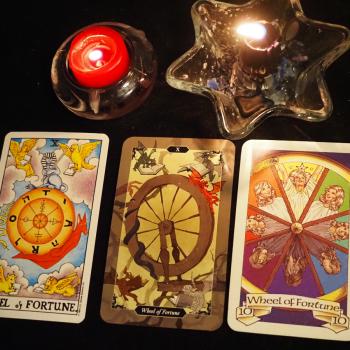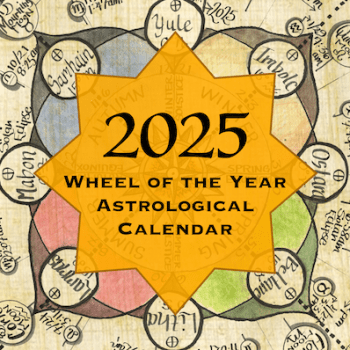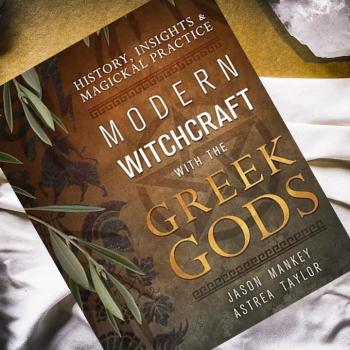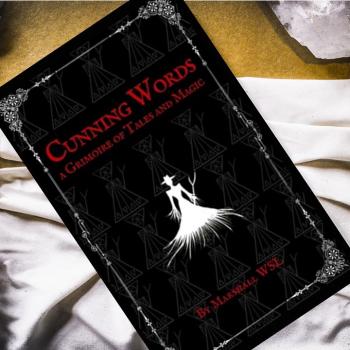Initially I was delighted by the arrival of Anita Kraft’s new book on Qabalah, The Qabalah Workbook for Magicians: A Guide to the Sephiroth. I’d been looking for a way to deepen my understanding of Western Qabalah that didn’t require wading through Aleister Crowley’s dense, circular prose, but offered a bit more depth than what Lon Milo DuQuette has to offer. The course of study that Kraft seemed to be offering excited me, though the first thing I learned was that Kraft would argue “course of study” is not what she’s offering at all: her main objective in the book is to get the readers off the page and into the Sephiroth, the 10 points on the Qabalistic Tree of Life. The quote from the back cover neatly sums up the book’s ethos: “Qabalah is experiential, as is mysticism and magick. If all you do is read, you are not a mystic or a Qabalist. You must do!”
I will admit here and now that I am not a Qabalist: all I did was read. Sadly my deadline for this review was a scant month after I received the book, and thus I had neither the time nor the money to complete the whole of the exercises in the book as Kraft suggests the reader do them. She lays out a course of study 10 months in duration: one month for each of the 10 Sephiroth on the Tree of Life, during which you meditate at the altar you create twice a day. The altar that you create for each Sephirah should consist of:
– An altar cloth in the Sephirah’s color
– Its zodiacal and planetary representation
– Tarot cards
– Perfume
– Magical weapons
– Precious stone
– God or goddess statue
– Animals, plants
– Magical power
– Robes that reflect the Sephirah
– Any other items you think might fit
Through these altars the reader can then explore the correspondences of each Sephirah through a series of questions posed by Kraft in the workbook and through copious amounts of journaling. I can’t overstate this: there is a lot of writing that is strongly, if not sternly, encouraged by this book as a way experiencing the magic of the Tree of Life.
As I read through each of the chapters it became more and more clear that the scope of the work involved was beyond my willingness to commit to it. Just the cost alone for the creation of 10 altars and their items was off-putting. While the text kindly suggests that “for all gemstones of the Sephiroth, you can purchase inexpensive faceted rondells on a string,” Kraft’s emphasis on obtaining genuine gems whenever possible seems to contradict this compromise: “The ruby is a precious gem and cut versions of it are expensive. It is preferable to obtain a cut ruby, however, not a rough one… Borrow one if you have to, but get a real ruby, not a synthetic one.”
It’s clear that Kraft has been powerfully moved by her experience of Qabalah and is an intensely committed practitioner. She has a tattoo of the Qabalistic lamen, or rosy cross, over her heart, and feels “strongly that, over time, a magician should acquire all of the magical weapons and learn how to use them for their utilitarian purpose.” This earnestness shines through in her commitment to making the practice of the reader as authentic as possible, but her encouragement often felt more militant than enlivening. Her presentation of the practice seems to leave little room for compromise or adjustment, and her repeated admonishment to journal becomes a monotonous chore rather than an interesting exploration.
The overly-earnest presentation of the material leaves little room for humor or personality. A huge part of Lon Milo DuQuette’s success at bringing Qabalah to the masses was the humor with which he leavened his otherwise dry bread. Outside of DuQuette’s glowing introduction to this volume, you’ll find none of his self-deprecating humor in Kraft’s text. The Workbook is earnest, at times gratingly so, and left me wondering where the joy in this practice might be found.
In the end it is up to you, dear reader, to get the most out of this book. It has a lot to offer the serious, dedicated and probably at least moderately wealthy student, but for me it did not stimulate an adventure into the Sephirotic ether, but rather left me overwhelmed and uninspired by the time, energy, and resources required. Certainly any reader could easily adapt the exercises in the workbook to their own ends: reduce the time and items on the altar or work the Sephiroth in their own order according to their preference, but that seems to defeat the spirit of the book. Ultimately, the Workbook feels more useful as a quick reference for factual and inspirational ideas around the Sephiroth than it does as a guide to a long and satisfying mystical journey up the Tree of Life.
[The Qabalah Workbook for Magicians: A Guide to the Sephiroth. By Anita Kraft. Foreword by Lon Milo DuQuette. Softcover: Weiser Books, $19.95. 176 pages.]
 Adam Blodgett is an artist, writer, and designer with a deep interest in magick and its everyday applications. He lives in Olympia, Washington, where he runs Pixelsmith Design and works feverishly to finish his super-cute tarot deck, the Chibi Tarot.
Adam Blodgett is an artist, writer, and designer with a deep interest in magick and its everyday applications. He lives in Olympia, Washington, where he runs Pixelsmith Design and works feverishly to finish his super-cute tarot deck, the Chibi Tarot.


















